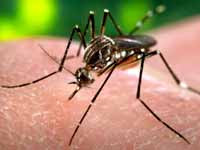GENEVA - SWINE flu has infected 94,512 people worldwide and been blamed for 429 deaths since it was first detected in April, the World Health Organisation said Monday.
The A(H1N1) virus has now spread to 136 countries and territories, the WHO said in its latest update, which shows 4,591 new cases and 47 more deaths since the last numbers released on Friday.
Australia is the worst-affected country in the Asia-Pacific region with 5,298 cases, followed by Thailand, on 2,076, where the number has gone up by 662 cases since the last report. Singapore has 1,055 cases.
Britain remains the worst hit in Europe with 7,447 cases. – AFP

WHO ALERT PHASE: 6 (June 11,2009)
Widespread human infection
Stay home for seven days if you are returning from:
Australia, Argentina, Canada, Chile, Dominican Republic, Hong Kong, Indonesia, Japan, Mexico, Panama, Philippines, Spain, Thailand, United States, United Kingdom.
 July 8, 2009
July 8, 2009Influenza A(H1N1): 7 cadets ill, 43 have symptoms
MALACCA: Seven trainees at Akademi Laut Malaysia (Alam) in Kuala Sungai Baru, Alor Gajah have been found positive for influenza A (H1N1). Another 43 are reportedly suffering from an influenza-like symptoms.
The seven -- two foreigners and five Malaysians -- have been isolated while the 43 are being quarantined at the academy's hostel.
There are 1,109 people in home quarantine, with six displaying flu-like symptoms.
July 7,2009
Influenza A (H1N1): Situation 'has reached critical level'
PUTRAJAYA: The influenza A (H1N1) situation has reached critical level in the country and health authorities will soon focus on mitigation rather than containment.
Mitigation phase is when there is sustained community spread and new cases have no defined epidemiological links with existing cases.
Yesterday, a second generation of local transmission was reported.
Health Minister Datuk Seri Liow Tiong Lai advised Malaysians to observe personal hygiene to avoid a major outbreak.
"Those who are sick should use a face mask to prevent infecting others. Go to the nearest hospital if you are sick."
He warned that although the virus was not deadly, it could become virulent if it mutated.
Health Ministry disease control director Datuk Dr Hasan Abdul Rahman warned that 2.6 million Malaysians could be infected if they did not heed the warning.
As of 8am yesterday, 75 new cases were reported -- 41 imported and 34 local transmissions -- bringing the total to 434 cases.
Among the confirmed cases are 15 of the 165 delegates to the Asia-Pacific pharmaceutical conference held in Penang from June 27 to 30.
July 6,2009
H1N1 infection moves to second generation
Local transmission of Influenza A(H1N1) has reached second generation and the Health Ministry views this as serious.
Soon, Malaysia will be moving from containment to mitigation to tackle the disease, says Health Minister Datuk Seri Liow Tiong Lai.
As of noon today, the Health Ministry has reported 75 new cases of H1N1, with 41 imported cases and 34 local transmission.
The total number of cases todate is 431, of which 333 are imported cases; and 101 local transmission.

Healthcare: Are we overreacting to H1N1?
By : DR ONG HEAN TEIK, Penang
IN this globalised world, different countries seem to be responding differently to the influenza A (H1N1) outbreak.
In the United States -- the country with the largest number of cases -- there are no thermal scanners at the airports. In Japan, with more than 900 cases, travellers only need to fill a health declaration form.
In Singapore and Malaysia, airports have thermal scanners, hospitals have special tents for suspected cases, quarantine is mandatory and schools have been closed.
Although new, this flu does not appear to be dangerous. The World Health Organisation update on June 26 lists 59,814 confirmed cases with only 263 deaths, giving a mortality rate of less than 0.5 per cent.
Our response to the flu outbreak may have been inappropriately influenced by the experience with SARS, which had a mortality rate ranging from 15 to 19 per cent.
In fact, the American Centres for Disease Control (CDC) states that "not all patients with suspected H1N1 need to be seen by a healthcare provider, only patients with severe illness or those at high risk of complications".
CDC says that "not all people with suspected H1N1 infection need to have the diagnosis confirmed, especially if the illness is mild".
While our policy is to quarantine healthcare workers who may be exposed to suspected H1N1 patients, CDC states that "healthcare workers who do not have a febrile respiratory illness may continue to work" and even "asymptomatic healthcare workers who have had an unprotected exposure to H1N1 also may continue to work if they are started on antiviral prophylaxis".
Although H1N1 is a benign infection, it is highly contagious. Over a week from June 19 to 26, the number of H1N1 patients in Singapore jumped from 100 to 365. Singapore has only a small geographical area in which it has to trace contacts and enforce quarantine using a highly-trained and efficient healthcare service to implement its policies. Yet being an open trading country, Singapore's containment measures have not been successful in preventing the spread of the virus in the local community.
Malaysia is a similarly open country with a much larger area as well as multiple entry ports and airports; we are unlikely to succeed where Singapore has failed. Instead of expanding the number of people quarantined, forcing employers to give full pay unrecorded leave and increasing the strain on our healthcare personnel, we may be better off bypassing the Singapore experience to follow what CDC is recommending.
The Health Ministry has initiated numerous measures to contain the flu outbreak. Yet patients have expressed unhappiness after experiencing these measures. We are using valuable healthcare resources, both human and material, in this containment policy against the virus.
KUALA LUMPUR: Malaysia's stringent measures in combating the H1N1 flu has created fear among foreign visitors.
This has caused them to stay away from visiting the country for the time being.
Tourism Minister Datuk Seri Ng Yen Yen, as well as various players in the tourism industry are worried that should the trend continue it would affect the sector.
MAS chief executive officer Datuk Seri Idris Jala said one had to restrain oneself from being an alarmist when dealing with H1N1.
"We are taking matters a bit more robustly," he said.
"More deaths arise from dengue fever," he said.
The death ratio for SARS, he said was higher at 1 to 12 compared with H1N1 at 1 to 220.




